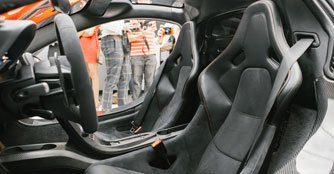The design intentions of the McLaren P1
08 Jul 2013|9,138 views
The highly awaited plug-in hybrid supercar by McLaren was first shown as a concept at the Paris Motor Show last year in 2012. Although considered as the McLaren F1 successor utilising hybrid power and Formula One technology, the McLaren P1 styling will not have the same seating layout as its predecessor.
Interestingly, as with the McLaren F1 road car of 1992, the McLaren P1 is a rear-wheel drive, mid-engine design that uses a carbon fibre monocoque and roof structure safety cage concept called MonoCage, which is a development of the MonoCell used in the current MP4-12C and 12C Spider that we tested just early this month.
As such, we decided to get in touch with both Frank Stephenson (FS) - Design Director of McLaren Automotive as well as Marcus Korbach (MK) - Brand Manager of McLaren P1 to get an inside story of the brand and supercar.
SGCM: The tagline - Designed by Air - Can you tell us more about it?
FS: Basically it's almost like a buzz word. Of course, air didn't design the car. Basically what it means is that in a nomal car company they design cars and have to sell them because customers have to have an emotional connection with the product. He has to like the car and then he'll buy it - an extension of the personality, you could say.
Strangely enough, what has not been done before is the design language that we use at McLaren, which is actually not design from a design point of view. In other words, I won't design a race car to look beautiful. I'll design it to win. You don't design a jet to look beautiful. You design it to fly and be effective. That's the approach we use with the McLaren P1 because we didn't want the car to look like it was just designed to be pretty. The principles we use to design had to be based on McLaren's racing history, design and technology.
With the McLaren P1, it has to be emotionally appreciated by the client. The design was influenced by science and nature and not just crazy stuff and that is really effective because nobody designs a car that way. So if we do it, McLaren will be the first one. It's incredible and is a very unique looking design language and very effective. So of course Designed by Air not only means it's very aerodynamic but also very unaerodynamic in a certain way. It's aerodynamic because the car can cut through the air. Unaerodynamic because the car makes use of air to keep the car glued to the ground. We use a lot of scientific principles and nature to design the car. So that explains the tagline.
SGCM: With the P1 having the necessary hybrid components, were there any compromise you had to make in terms of design?
FS: The electric system didn't give it any compromises. It gave us a challenge. We knew we were going to go down this route very early. We are running two big turbos and we want to absolutely eliminate turbo lag and add horsepower from the electric motor for a linear power delivery. Plus we were able to uniquely design the car such that it's able to be driven solely on electric mode. The package of the car is so efficient even with the weight of the batteries.
MK: Just to add to that, Frank worked together with the engineers and aerodynamicists from the first day on and when we looked at early concept drawings of the prototype and what we have now, it's the same thing. One thing that's disappointing is having the production model being very different as the initial mind-blowing concept or prototype that you see at car shows. The P1, on the other hand, delivered something right from the beginning that's extreme and carried on with it and it was fine from every angle.
 |
SGCM: Then, Marcus, how does McLaren aim to differentiate itself from other supercar manufacturers such as Ferrari and Lamborghini?
MK: Well, first of all we don't look at them and ask ourselves what we want to be. We have our own progression and where we want to position ourselves. Everything starts with the driver. So we start off the other way around. We work with the dimensions of the driver first before working our way outwards. But a lot of car companies design the car first before realising there's a problem with fitting drivers in. This causes a very unnatural position which is totally different from McLaren cars.

FS: The client of McLaren is obviously different from Ferrari's because our customers are more of connoisseurs who know about cars. You get a lot of sportsman or actors buying Ferrari because it's a well known brand. So if you know about McLaren, it's a good thing. It's almost like the secret brand where only the insider guys know about. This will change obviously in years to come. At the moment people may think McLaren is a small company because we only have the MP4-12C Coupe and Spider and the P1. But what they don't know is there'll be something new every year from McLaren from here on end.
SGCM: On that note, why did McLaren decide to venture and expand its road car production (the initial MP4-12C and now the P1) after a long break from the McLaren F1?
FS: The initial strategy was always to do three segments of the market: the sportscar, the supercar and the hypercar. When I started in 2008, they were just finishing up the SLR, which was a co-production between McLaren and Mercedes-Benz, and the only car they ever did before that was the McLaren F1, which was the supercar of the 20th century. But Ron Dennis potentially felt we could increase the appeal for McLaren. Plus, we have all the technology to make a hybrid hypercar, a supercar or a sportscar.
MK: Also when the McLaren F1 came out, we defined a new market, which was a car that could produce that kind of performance at that kind of price. Then the cooperation with Mercedes-Benz started. The SLR, in a lot of ways, had a lot of compromises for McLaren because both companies had different aims. It's a good car, no doubt, but it was a best of both worlds. McLaren then took the decision to proceed with further projects, which started even when the SLR was in the process of creation. Since then, we decided that there will be no compromises or carry-over parts.
The highly awaited plug-in hybrid supercar by McLaren was first shown as a concept at the Paris Motor Show last year in 2012. Although considered as the McLaren F1 successor utilising hybrid power and Formula One technology, the McLaren P1 styling will not have the same seating layout as its predecessor.
Interestingly, as with the McLaren F1 road car of 1992, the McLaren P1 is a rear-wheel drive, mid-engine design that uses a carbon fibre monocoque and roof structure safety cage concept called MonoCage, which is a development of the MonoCell used in the current MP4-12C and 12C Spider that we tested just early this month.
As such, we decided to get in touch with both Frank Stephenson (FS) - Design Director of McLaren Automotive as well as Marcus Korbach (MK) - Brand Manager of McLaren P1 to get an inside story of the brand and supercar.
SGCM: The tagline - Designed by Air - Can you tell us more about it?
FS: Basically it's almost like a buzz word. Of course, air didn't design the car. Basically what it means is that in a nomal car company they design cars and have to sell them because customers have to have an emotional connection with the product. He has to like the car and then he'll buy it - an extension of the personality, you could say.
Strangely enough, what has not been done before is the design language that we use at McLaren, which is actually not design from a design point of view. In other words, I won't design a race car to look beautiful. I'll design it to win. You don't design a jet to look beautiful. You design it to fly and be effective. That's the approach we use with the McLaren P1 because we didn't want the car to look like it was just designed to be pretty. The principles we use to design had to be based on McLaren's racing history, design and technology.
With the McLaren P1, it has to be emotionally appreciated by the client. The design was influenced by science and nature and not just crazy stuff and that is really effective because nobody designs a car that way. So if we do it, McLaren will be the first one. It's incredible and is a very unique looking design language and very effective. So of course Designed by Air not only means it's very aerodynamic but also very unaerodynamic in a certain way. It's aerodynamic because the car can cut through the air. Unaerodynamic because the car makes use of air to keep the car glued to the ground. We use a lot of scientific principles and nature to design the car. So that explains the tagline.
SGCM: With the P1 having the necessary hybrid components, were there any compromise you had to make in terms of design?
FS: The electric system didn't give it any compromises. It gave us a challenge. We knew we were going to go down this route very early. We are running two big turbos and we want to absolutely eliminate turbo lag and add horsepower from the electric motor for a linear power delivery. Plus we were able to uniquely design the car such that it's able to be driven solely on electric mode. The package of the car is so efficient even with the weight of the batteries.
MK: Just to add to that, Frank worked together with the engineers and aerodynamicists from the first day on and when we looked at early concept drawings of the prototype and what we have now, it's the same thing. One thing that's disappointing is having the production model being very different as the initial mind-blowing concept or prototype that you see at car shows. The P1, on the other hand, delivered something right from the beginning that's extreme and carried on with it and it was fine from every angle.
SGCM: Then, Marcus, how does McLaren aim to differentiate itself from other supercar manufacturers such as Ferrari and Lamborghini?
MK: Well, first of all we don't look at them and ask ourselves what we want to be. We have our own progression and where we want to position ourselves. Everything starts with the driver. So we start off the other way around. We work with the dimensions of the driver first before working our way outwards. But a lot of car companies design the car first before realising there's a problem with fitting drivers in. This causes a very unnatural position which is totally different from McLaren cars.

FS: The client of McLaren is obviously different from Ferrari's because our customers are more of connoisseurs who know about cars. You get a lot of sportsman or actors buying Ferrari because it's a well known brand. So if you know about McLaren, it's a good thing. It's almost like the secret brand where only the insider guys know about. This will change obviously in years to come. At the moment people may think McLaren is a small company because we only have the MP4-12C Coupe and Spider and the P1. But what they don't know is there'll be something new every year from McLaren from here on end.
SGCM: On that note, why did McLaren decide to venture and expand its road car production (the initial MP4-12C and now the P1) after a long break from the McLaren F1?
FS: The initial strategy was always to do three segments of the market: the sportscar, the supercar and the hypercar. When I started in 2008, they were just finishing up the SLR, which was a co-production between McLaren and Mercedes-Benz, and the only car they ever did before that was the McLaren F1, which was the supercar of the 20th century. But Ron Dennis potentially felt we could increase the appeal for McLaren. Plus, we have all the technology to make a hybrid hypercar, a supercar or a sportscar.
MK: Also when the McLaren F1 came out, we defined a new market, which was a car that could produce that kind of performance at that kind of price. Then the cooperation with Mercedes-Benz started. The SLR, in a lot of ways, had a lot of compromises for McLaren because both companies had different aims. It's a good car, no doubt, but it was a best of both worlds. McLaren then took the decision to proceed with further projects, which started even when the SLR was in the process of creation. Since then, we decided that there will be no compromises or carry-over parts.
Thank You For Your Subscription.





























